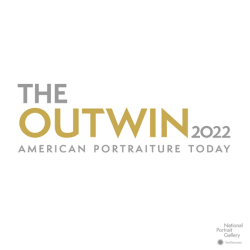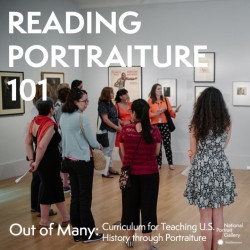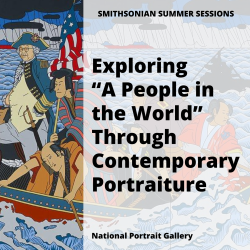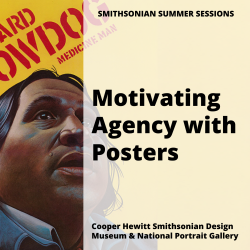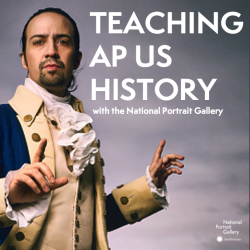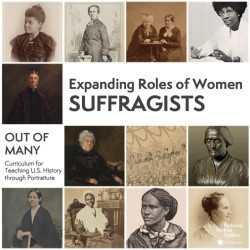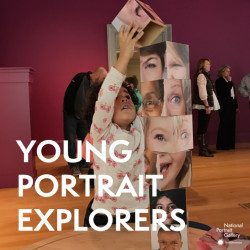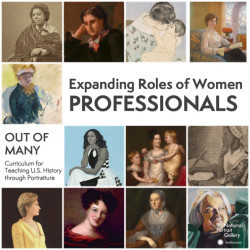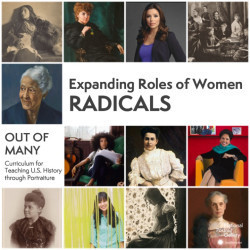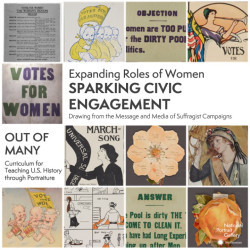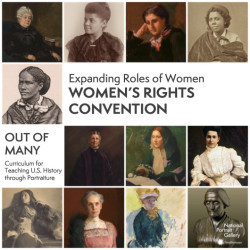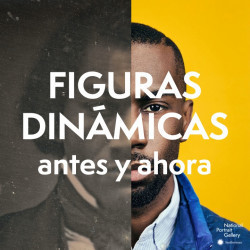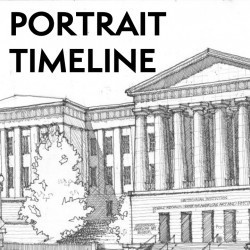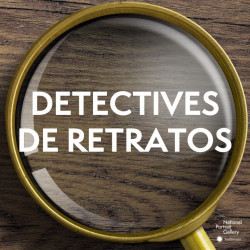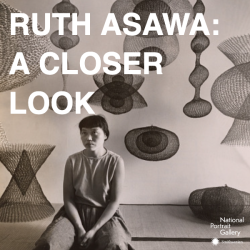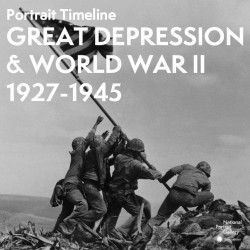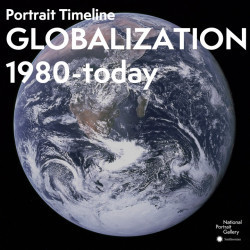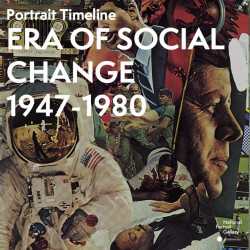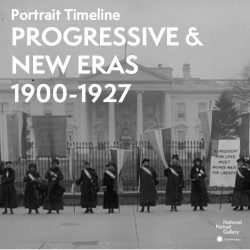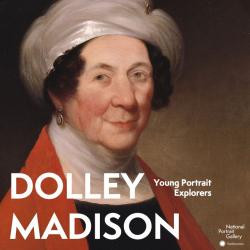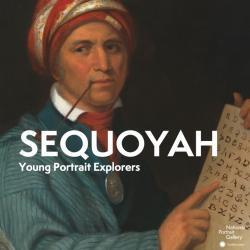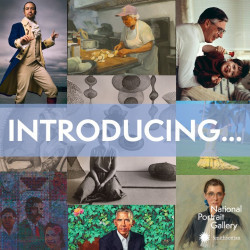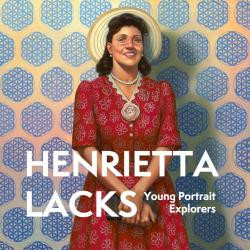Nicole Vance Nash's collections
The Outwin 2022: American Portraiture Today
<p>Explore portraits from <em>The Outwin 2022: American Portraiture Today </em>at the National Portrait Gallery in this Learning Lab collection.</p>
<p><em></em><em>The Outwin 2022: American Portraiture Today</em> presents 42 portraits selected through an open call that garnered more than 2,700 entries from artists working across the United States and Puerto Rico. The artists responded with works that engage contemporary society, many providing new insights into the unprecedented reality we have experienced in the time surrounding the COVID-19 pandemic.</p>
<p>The selected finalists create artworks in a wide range of media, including painting, drawing, photography, sculpture, textiles, video, and performance. They demonstrate how capacious and changing the genre of portraiture can be, and illuminate the genre's power to make visible a multitude of life experiences.<br></p>
<p>To best view the video and performance pieces, visit the <em>The Outwin 2022: American Portraiture Today</em><em>'s </em><a href="https://portraitcompetition.si.edu/exhibition/2022-outwin-boochever-portrait-competition/?lang=eng">website</a>.</p>
<p>Every three years, the National Portrait Gallery invites both emerging and established artists working in the U.S. to submit a recent portrait to the Outwin Boochever Portrait Competition. Around fifty works are then selected by expert jurors who, on average, review more than 2,500 entries. The competition has evolved since its inception in 2006 to include performance art and time-based media alongside painting, photography, drawing, and sculpture.</p>
<p>As part of its deep commitment to supporting contemporary artists working in portraiture, the National Portrait Gallery looks to the Outwin to share the genre’s remarkable relevance and strengthen the visual representation of American history. Each iteration of the competition gauges portraiture’s progression while underscoring the potential of one person to make an impact.</p>
<p>The Outwin is made possible through the Virginia Outwin Boochever Portrait Competition Endowment, established by Virginia Outwin Boochever (1920–2005), who served as a docent for the National Portrait Gallery for nearly two decades. Mrs. Boochever’s vision for the Outwin is now carried out by her children.</p>
<p>Educators, to explore these portraits with your students through close looking and visible thinking routines, see the resources at the end of this collection for ideas.</p>
<p>#NPGteach</p>
 Nicole Vance Nash
Nicole Vance Nash
60
Reading Portraiture 101
<p>A portrait is a type of artwork created by artists that illustrate the likeness or image of a person or persons. They can lend insights into history and biography. Portraits can also prompt writing in the classroom, inspire students to create self-portraits, and even offer fruitful ties to multiple disciplines, such as science and mathematics.</p>
<p>In this Learning Lab Collection, educators will learn how to teach students to spot visual clues in portraits and respond to them. In order for students to do so, they need a set of tools to guide them. In this section, educators will find the following tools:<br></p>
<ul><li><em>Defining Portraiture</em> provides educators with a basic lexicon on portraiture.</li></ul>
<ul><li><em>Elements of Portrayal</em> are a series of visual clues that can help students observe and analyze portraiture. Moreover, these different elements relay not only the story of a portrait’s sitter but also the historical and social context in which the portrait was created.</li></ul>
<ul><li><em>Teaching Strategies</em> are a series of protocols that educators can use alongside portraits to bolster learners’ engagement and study. Some of these will be used in some of the lessons throughout the Out of Many curriculum guide.</li></ul>
<ul><li><em>Introducing Portraiture to Students</em> describes an activity that educators can use to begin working with portraits. Students may also fill out the <em>Reading Portraiture</em>
graphic organizer as they investigate each portrait.</li></ul>
<p>Reading Portraiture 101 is associated with the Out of Many Curriculum Guide Series, of which <a href="https://learninglab.si.edu/q/ll-c/pPEjlxzvSDYKI29e">Expanding Roles of Women</a> is the first.</p>
<p>#NPGteach</p>
 Nicole Vance Nash
Nicole Vance Nash
53
Exploring “A People in the World” Through Contemporary Portraiture (Smithsonian Summer Sessions)
<p>How can portraiture reveal what it means to be an American in a global context? Inspired by Educating for Democracy's <a href="https://www.educatingforamericandemocracy.org/the-roadmap/7themes/#people-in-the-world">"A People in the World" theme</a>, this collection gathers resources and pedagogical approaches to support the 2022 <em>Smithsonian Summer Sessions</em> workshop, “Exploring “A People in the World” Through Contemporary Portraiture,” by introducing techniques to engage students in civic engagement.</p>
<p>Workshop facilitated by National Portrait Gallery Educators Irina Rubenstein and Briana Zavadil White.</p>
<p><strong>Learning Objectives</strong></p>
<p>Students will:<br></p>
<ul><li>Engage in observation and analysis of portraiture (visual literacy; critical thinking)</li><li>Explore different experiences and perspectives in order to examine what it means to be "a people in the world."</li><li>Utilize portraiture to connect to the bigger picture and educate for global competence.</li></ul>
<ul></ul>
<p>#SummerSessions #NPGteach</p>
 Nicole Vance Nash
Nicole Vance Nash
16
Young Portrait Explorers
<p>Explore portraits of astronauts and activists, scientists and star athletes—and discover the stories behind them! Use the following collections to engage young learners with portraiture through close looking, movement, and art-making.</p>
<p>Choose a portrait, open the collection, and explore art, history, biography and more!</p>
<p>#NPGteach</p>
 Nicole Vance Nash
Nicole Vance Nash
66
Expanding Roles of Women: Professionals
<p>In this Learning Lab collection, professionals featured in the Smithsonian’s National Portrait Gallery exhibition,<em> Out of Many: Portraits from 1600 to 1900 </em>are used as entry points to teach about the history of the women's work.<br></p>
<p>In the nineteenth century, women increasingly took on roles in public life. During the early Republic, Sarah Weston Seaton, the wife of a newspaper publisher, became a consummate host of political elites in her Washington, D.C., home. Women artists, such as Sarah Miriam Peale and Mary Cassatt, painted commissioned portraits of powerful individuals and ordinary scenes of domestic life, respectively. Writers like Charlotte Perkins Gilman advocated for fundamental shifts in women’s economic and social power. According to Gilman, women’s labor should not be restricted to the domestic sphere. Rather, they deserved the freedom to pursue professions outside of the household. In this collection, students will study women’s entrance into the professional sphere, where they set forth their ideas through the arts, public speaking and events, and campaigning.</p>
<p>In addition, students will examine not only the portraits subjects but will also; gain insist into the larger historical time period in which the subjects lived, understand how the women in these portraits lived and located agency, and reflect on the present by considering how women continue to make changes in society.</p>
<p>This collection contains three lessons that highlight themes relating to women and work: "Reading Portraiture: Claim, Support, Question," "Engaging History: Valuing the Work of Women," and "Connections to the Present: Tracking a Journey in the Public Eye." </p>
<hr>
<p><strong>Reading Portraits: Claim/Support/Question</strong></p>
<p>Students will gradually uncover Mary Cassatt’s life through the “Claim, Support, Question” strategy from Reading Portraiture 101. They will enter the lesson by analyzing the portrait without knowing the identity of its subject or any background information.</p>
<p>As more evidence is revealed to students, they will make truth claims about who they think Mary Cassatt was. Second, they will use evidence to support or question their claims. Students will then synthesize all the evidence they have examined in a written reflection on Mary Cassatt’s life and values. Teachers will conduct a class discussion about what they have learned. To supplement this history, Sarah Miriam Peale and Edmonia Lewis will be introduced as the predecessor to and contemporary of Cassatt, respectively. Students will have the opportunity to explore additional professional women artists from the nineteenth century to the present through a variety of extension activities.</p>
<p>Essential Questions</p>
<ul><li>What can a portrait tell us about someone’s life?</li><li>How can historical evidence help us make inferences about a person’s story?</li></ul>
<p>Objectives </p>
<ul><li>Students will interpret the message an artist conveys through their self-portrait.</li><li>Students will analyze and synthesize visual and written evidence to draw conclusions about their claims</li></ul>
<hr>
<p><strong>Engaging History: Valuing the Work of Women</strong></p>
<p>Students will explore the portraits and lives of Sarah Weston Seaton and Charlotte Perkins Gilman. Working in groups, students will identify the spaces these women carved out for political and creative work in a society that largely relegated them to the home.</p>
<p>Seaton, the wife of a prominent Washington, D.C., newspaper editor, was a keen observer and host of political life in the early Republic—all while raising eleven children.</p>
<p>Born in 1860, over seven decades after Seaton, Gilman shunned the confines of nineteenth-century domesticity. Instead, she pursued a robust career as a writer, lecturer, and artist, often addressing the topic of women’s unacknowledged economic contributions. </p>
<p>Even with their considerable racial and class privilege, Seaton and Gilman grappled with the restrictions and expectations of their times: marriage, child-rearing, running a household, and entertaining guests, among myriad other duties. By examining</p>
<p>Seaton’s and Gilman’s portraits and related primary sources, students will determine which activities counted as labor for these women.</p>
<p>Essential Questions</p>
<ul><li>What counts as work?</li><li>What kind of work is valued in your society? What kind of work is undervalued?</li><li>How do women locate agency, even when they are held back by a society’s norms?</li></ul>
<p>Objectives </p>
<ul><li>Use primary sources to infer the conditions of women’s lives and livelihoods.</li><li>Prepare a claim about women and work that is based on primary sources.</li></ul>
<hr>
<p><strong>Connections to the Present: Tracking a Journey in the Public Eye</strong></p>
<p>In this lesson, students will learn about contemporary women who have played prominent roles in American politics and culture.</p>
<p>To what extent do these women, especially those with proximity to power, draw on their lived experiences to fuel their platforms? By focusing on a living first lady, students will outline how women in power navigate life in the public eye.</p>
<p>Essential Questions</p>
<ul><li>How does prior experience shape a life in public service?</li><li>Which biographical factors inform the aims of women in politics?</li></ul>
<p>Objectives </p>
<ul><li>Track the biography of a first lady and study how prior life experiences shaped her life in the White House.</li><li>Summarize key findings from web-based research; categorize research and make judgments.</li></ul>
<hr>
<p>#NPGteach #OutOfMany</p>
<p>Keywords: Professionals, Mary Cassatt, Women Artists, Sarah Miriam Peale, Edmonia Lewis, Impressionists, Impressionism, Working Women, Sarah Weston Seaton, Charlotte Perkins Gilman, Phillis Wheatley, Anne Catherine Hoof Green, Betty Friedan, First Ladies, Hillary Clinton, Laura Bush, Michelle Obama, Melania Trump, Web Research, Primary Sources, Claim/Support/Question</p>
 Nicole Vance Nash
Nicole Vance Nash
78
Expanding Roles of Women: Radicals
<p>In this Learning Lab collection, radical women featured in the Smithsonian’s National Portrait Gallery exhibition,<em> Out of Many: Portraits from 1600 to 1900, </em>are used as entry points to teach about the history of radicals during this time period.<br></p>
<p>From 1600 to 1900, women dramatically expanded their roles in politics and the professional sphere, including the arts. This set of Teaching Ideas explores the biographies and careers of those “radical” women who dared to create change in the cultural, political, and social spheres. Specifically, these lessons highlight Indigenous and Black activists who, despite being excluded from the broader suffrage movement, forged inroads for education and public awareness of racial inequities. The multi-hyphenate Zitkála-Šá grew up on the Yankton Sioux reservation in South Dakota. She cultivated her skill as a musician and writer, all in the face of forced assimilation at an Indian boarding school. Later, she advocated for Native American suffrage. Mary Church Terrell and Ida B. Wells-Barnett were influential political organizers. The increasing racial terrorism inflicted upon African American men ignited their activism. They would later become leaders in the women’s suffrage movement, founding clubs and organizations that would become hotspots for political mobilization. This section also addresses the ways that women artists and intellectuals used portraiture to promote a certain “visual identity,” or the elements and stylings that shape their public image.</p>
<p>Throughout this collection, students will examine not only the portrait subjects but will also gain insight into the larger historical time period in which the subjects lived, understand how the women in these portraits lived and located agency, and reflect on the present by considering how women continue to make changes in society.</p>
<p>This collection contains three lessons that highlight radical women: "Reading Portraiture: A Different Schooling," "Engaging History: Making Inferences with Primary Sources," and "Connections to the Present: Visual Identity."</p>
<p><strong><br></strong></p>
<p><strong>Reading Portraiture: A Different Schooling</strong><br></p>
<p>Students will gain an understanding of Zitkála-Šá’s experiences as a student and teacher at Indian boarding schools, particularly regarding how those experiences shaped her cultural identity and activism. To begin the lesson, students will explore their own identities. They will then compare and contrast two portraits of Zitkála-Šá. In addition, they will analyze an excerpt from one of Zitkála-Šá’s short stories.</p>
<p>Essential Questions</p>
<ul>
<li>How did Indian boarding schools impact the identities of Native Americans? What are their generational effects on Native cultures?</li>
<li>How do portraits demonstrate the complex identities of individuals?</li>
<li>What can we learn about an author’s beliefs by reading their work?</li>
</ul>
<p>Objectives</p>
<ul>
<li>Students will consider the complexities of their own identities and think about how they would represent themselves in a portrait.</li>
<li>Students will compare and contrast different portraits of Zitkála-Šá to consider the facets of the subject’s identity.</li>
<li>Students will analyze and annotate a primary source document.</li>
</ul>
<hr>
<p><strong>Engaging History: Making Inferences with Primary Sources</strong></p>
<p> </p>
<p>Students will examine cultural artifacts to gain an understanding of Mary Church Terrell’s radical approach to racial equality and women’s suffrage. First, students will read a portrait of Terrell, using the “See/Think/Wonder” thinking routine to spark their curiosity. Second, the teacher will model how to investigate primary sources and record inferences on a graphic organizer. Then student groups will move through a Gallery Walk to analyze a variety of primary sources and fill out their own inferences.</p>
<p>Essential Questions</p>
<ul><li>How can portraits initiate a deeper analysis of a person’s biography?</li><li>What can primary sources tell us about women activists in history?</li><li>How has Mary Church Terrell paved the way for today’s activists?</li></ul>
<p>Objectives</p>
<ul><li>Students will use thinking routines to begin a historical exploration of a portrait subject.</li><li>Students will analyze primary sources to make inferences about Mary Church Terrell’s life.</li><li>Students will compare the approaches of past and present activists</li></ul>
<p></p>
<hr>
<p><strong>Connections to the Present: Visual Identity</strong><br></p>
<p>In this lesson, students will determine what constitutes a “visual identity,” or the elements and stylings that shape a person’s public image. When people appear in public, they emphasize certain traits or characteristics, such as keen fashion sense, bold speech, or winsome facial expressions. On social media and other visual platforms, people savvily use physical appearance and personality to create a public-facing self.</p>
<p>Students will examine how portraiture was used to shape or define visual identity in the nineteenth century and how it is used today. Visual identity is a strategy to convey political aims and actions, as in the collective portrayal of suffragists and writers in Eminent Women. Alternately, visual identity can heighten a public version of the self, as in the striking pose of thespian Minnie Maddern Fiske. To conclude this lesson, students will draw connections between these nineteenth-century portraits and portraits of today’s radical women.</p>
<p>Essential Questions</p>
<ul><li>Which Elements of Portrayal contribute to an online presentation of the self?</li><li>Which values, identities, and actions can a work of art promote?</li><li>How have some women used portraiture to further their professional and political aims?</li></ul>
<p>Objectives</p>
<ul><li>Analyze the visual identity of the historical and contemporary portrait subjects.</li><li>Identify one present-day radical woman whose politics and personhood align with those of the historical women featured in the National Portrait Gallery’s portraits of Eminent Women and Minnie Maddern Fiske.</li></ul>
<hr>
<p>#NPGteach #OutOfMany</p>
<p>Keywords: Radicals, Women, Zitkala-Ša, Indian Boarding Schools, Yankton Dakota, American Indian Women, American Indian Citizenship, American Indian Activism, Primary Sources, Mary Church Terrell, Suffrage, M Street Colored School, Visual identity, Eminent Women, Minne Maddern Fiske, portraiture, portraits, </p>
 Nicole Vance Nash
Nicole Vance Nash
71
Portrait Timeline
<p>The National Portrait Gallery tells the story of the United States of America by portraying the people who shape the nation’s history, development and culture.</p>
<p>This collection organizes the portraits found within student programs chronologically. Learn more about The National Portrait Gallery's <a href="https://npg.si.edu/teachers/school-groups">virtual 2021-2022 student programs </a> and explore more of the <a href="https://learninglab.si.edu/org/npg">National Portrait Gallery's Learning Lab collections</a>.</p>
<p>#NPGteach</p>
<p><strong>Keywords: </strong>Portraits, Portraiture, Identity, Visual Arts, History, Famous Americans, Important People, Self-Portraits, Symbols, Artist, Medium, Model, Sitter, National Portrait Gallery, Paintings, Sculptures, Photographs</p>
 Nicole Vance Nash
Nicole Vance Nash
34
Detectives de Retratos
<p>Este Laboratorio de aprendizaje (Learning Lab) es un complemento del programa escolar 2020-2021, Detectives de Retratos, de la Galería Nacional de Retratos.</p>
<p>Los estudiantes se transformarán en detectives de retratos, e investigarán retratos y analizarán pistas para ampliar sus conocimientos acerca de personajes relevantes de los Estados Unidos. A través de debates interactivos y actividades de dibujo y escritura, los estudiantes podrán interpretar, comparar y contrastar retratos de toda la colección. Para ofrecer un mejor apoyo para el plan de estudios y favorecer los intereses de los estudiantes, este módulo está dividido en los siguientes temas: presidentes, activistas, íconos y científicos.</p>
<p><strong>Objetivos:</strong></p>
<p>Después de completar esta lección, los estudiantes estarán mejor preparados para: </p>
<ul><li> Identificar a estadounidenses importantes y analizar sus contribuciones a la historia de los Estados Unidos </li><li> Identificar los componentes claves de un retrato y analizar lo que podemos aprender sobre la figura retratada a través de estos componentes.</li></ul>
<p><strong></strong><strong>Enlaces de los planes de estudios:</strong></p>
<p>Este plan de clases es adecuado para alumnos de jardín de infantes a 3.er.
Grado (K-3) en las áreas de estudios sociales, artes del lenguaje y artes visuales.</p>
<p><a href="https://npg.si.edu/teachers/school-groups">Prepare</a> un programa virtual de Detectives de retratos con educadores de la Galería Nacional de Retratos.</p>
<p>#NPGteach</p>
<p>Palabras clave: estadounidenses famosos, presidentes, íconos, activistas, promotores de la justicia social, científicos, inventores, músicos, artistas, retratos, arte, celebridades, cantantes<br><br></p>
<p>La traducción de este recurso fue posible gracias al generoso patrocinio de Bank of America.</p>
 Nicole Vance Nash
Nicole Vance Nash
75
Ruth Asawa: A Closer Look
<p>Learn more about artist Ruth Asawa and her wire sculptures through portraits!</p>
<p>#NPGteach</p>
<p>Keywords: Asian American, Artist, Sculpture, Photographs, Portraiture</p>
 Nicole Vance Nash
Nicole Vance Nash
17
Progressive & New Eras (1900-1927) with the National Portrait Gallery
<p>This portrait timeline spotlights individuals who shaped the history, development, and culture of what is now the United States of America between the years 1910-1927.</p>
<p>#NPGteach</p>
<p>Keywords: Progressive Era, Women's Suffrage, Triangle Shirtwaist Factory Fire, Industrial, Workers, Prohibition, Nineteenth Amendment, Imperialism, </p>
 Nicole Vance Nash
Nicole Vance Nash
67
Dolley Madison: Young Portrait Explorers
<p>Learn how Dolley Madison shaped the role of first lady of the United States (the wife of a U.S. president) by serving as a trusted friend and hostess (someone who entertains people) to important guests at the White House.</p>
<p>#NPGteach</p>
<p><strong>Keywords:</strong> Dolley Madison, First Lady, White House</p>
 Nicole Vance Nash
Nicole Vance Nash
22
Capital Punishment: Pictured through Portraiture
<p>This Learning Lab complements a National Portrait Gallery custom student program for American University's Fall 2020 course, CORE-107 Complex Problems Seminar: Death Penalty Perspectives. </p>
<p>Students will analyze and discuss portraiture relating to capital punishment in the United States.</p>
<p>#NPGteach</p>
 Nicole Vance Nash
Nicole Vance Nash
17

